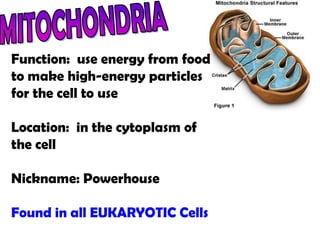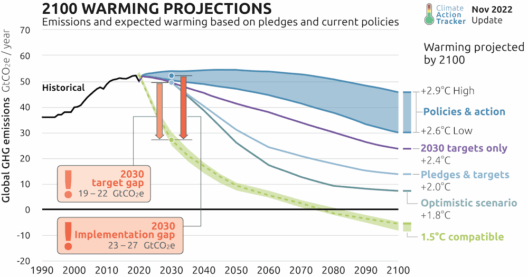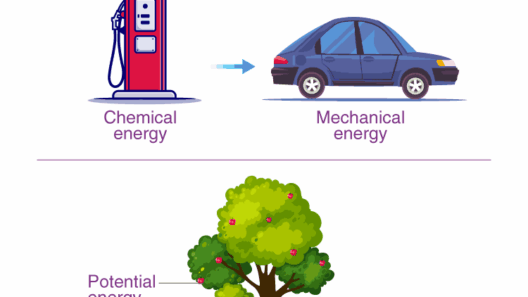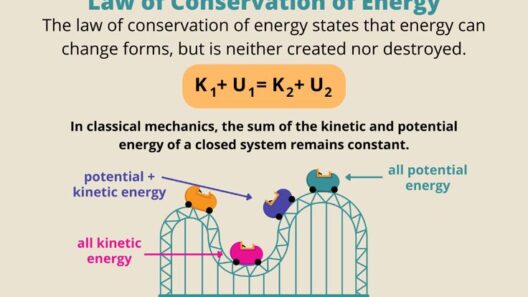The intricate world of cellular biology reveals a multitude of fascinating structures that contribute to the very essence of life. Among these structures, organelles perform a myriad of functions, with energy conservation being paramount for cellular efficiency. Understanding the roles of specific organelles can deepen our appreciation for the adaptability and resilience of living organisms. This discussion elucidates the pivotal functions of mitochondria, chloroplasts, and the endoplasmic reticulum as the three most significant energy-conserving organelles.
Mitochondria: The Powerhouses of the Cell
Mitochondria are often aptly referred to as the powerhouses of the cell, a moniker that encapsulates their fundamental role in energy production. These double-membraned organelles are primarily responsible for synthesizing adenosine triphosphate (ATP) through oxidative phosphorylation. The inner membrane of mitochondria houses the electron transport chain, a series of protein complexes. This system facilitates the transfer of electrons derived from the oxidation of nutrients.
The mitochondrial structure is a marvel in itself. It possesses an outer membrane that is permeable to small molecules, while the inner membrane is intricately folded into cristae, which significantly increase the surface area. This architectural feature is crucial for maximizing ATP production efficiency. The space enclosed by the inner membrane, known as the mitochondrial matrix, hosts enzymes that play a critical role in the citric acid cycle (Krebs cycle). Here, acetyl-CoA, derived from carbohydrates, fats, and proteins, is metabolized, releasing electrons that are subsequently utilized in ATP synthesis.
Furthermore, mitochondria are not merely passive energy producers. They exhibit a remarkable capacity for adaptability. Under conditions of energy scarcity, such as during prolonged exercise or fasting, mitochondria can shift their metabolism to utilize alternative fuel sources, thus ensuring cellular energy homeostasis. This flexibility underscores the dynamism inherent in cellular energy management.
Chloroplasts: Converters of Light Energy
Chloroplasts represent another critical organelle in the pantheon of energy-conserving structures, especially in photosynthetic organisms. These organelles facilitate the conversion of light energy into chemical energy, a transformative process fundamental to life on Earth. Located primarily in the cells of plant leaves, chloroplasts contain chlorophyll, a pigment that captures solar energy, initiating the intricate machinery of photosynthesis.
The photosynthetic process occurs in two main stages: the light-dependent reactions and the light-independent reactions, commonly referred to as the Calvin cycle. During the light-dependent reactions, which take place within the thylakoid membranes, sunlight is harnessed to split water molecules, releasing oxygen as a byproduct and generating ATP and NADPH. These energy carriers are then utilized in the Calvin cycle, occurring in the stroma of chloroplasts, where carbon dioxide is fixed into organic molecules, ultimately yielding glucose.
This conversion of solar energy into chemical bonds not only provides sustenance for the plant but also serves as the foundation for the entire terrestrial food web. The ability of chloroplasts to harness sunlight and synthesize organic compounds is a magnificent legacy of evolution, enabling life to thrive in diverse environments ranging from lush forests to arid deserts.
The Endoplasmic Reticulum: The Cellular Workspace
While mitochondria and chloroplasts often steal the limelight for their roles in energy conversion, the endoplasmic reticulum (ER) is an unsung hero in the realm of cellular energy conservation and management. This extensive membranous network extends throughout the cytoplasm and serves multiple roles, including the synthesis and modification of proteins and lipids. The ER is divided into two distinct regions: rough ER, studded with ribosomes, and smooth ER, devoid of ribosomes.
The rough ER plays a crucial role in protein synthesis, particularly those destined for secretion or use in cellular membranes. These proteins often require substantial energy during their synthesis and subsequent folding processes. Ensuring proper protein folding and quality control is vital for maintaining cellular functionality. Misfolded proteins can result in cellular stress, prompting energy-intensive processes such as protein degradation pathways.
On the other hand, the smooth ER is involved in lipid synthesis and the metabolism of carbohydrates. In addition to its synthetic roles, the smooth ER participates in detoxification processes, thereby conserving energy by mitigating cellular stress caused by toxins. This detoxification requires substantial energy; thus, the smooth ER’s efficiency directly impacts the cell’s overall energy conservation related to metabolic homeostasis.
Furthermore, the endoplasmic reticulum communicates intricately with mitochondria and other organelles, facilitating a smooth flow of metabolites essential for energy production and consumption. This inter-organelle dialogue enhances the cell’s ability to respond to fluctuating energy demands, showcasing the ER’s versatility.
Conclusion
The mitochondria, chloroplasts, and endoplasmic reticulum play indispensable roles in energy conservation within cells. Each organelle, with its unique structure and function, contributes to the efficient management of energy resources crucial for sustaining life. From the intricate processes of ATP synthesis in mitochondria to the transformative capabilities of chloroplasts in converting solar energy and the multifaceted roles of the endoplasmic reticulum in cellular metabolism, these organelles underscore the complexity and elegance of biological systems.
Ultimately, the study of these energy-conserving organelles fosters a deeper appreciation for the interplay between cellular structures and functions. Such understanding not only enriches our knowledge of cellular biology but also serves as a reminder of the importance of energy conservation in the broader context of environmental sustainability and ecological balance.








